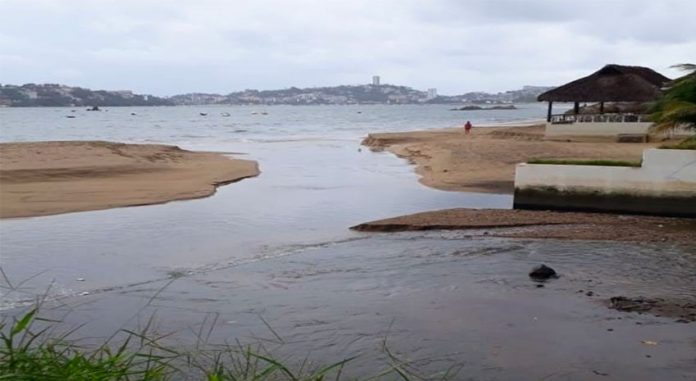Despite photos uploaded to social media earlier this week showing a large black plume of water entering Acapulco’s Santa Lucia Bay, the National Water Commission (Conagua) declared there was no discharge of sewage.
The discolored torrent, photographed pouring into the sea alongside the Krystal Beach Hotel, was instead overflow caused by stagnant water backing up in the city’s storm drains due to recent heavy rains, Conagua found.
“It is presumed that the stagnant water was the result of a remnant generated by extraordinary runoff that occurred during the previous night in the area, and that when mixed with stagnant water inside the Magallanes drainage canal, it generated runoff,” Conagua said in a statement.
A widely publicized sewage leak in June resulted in a criminal complaint against the city’s water utility, Capama, for environmental damage. The leak also caused Icaco beach to lose its coveted Blue Flag designation for cleanliness, and the mayor demanded the resignation of five Capama directors and the city’s head of ecology due to the breach.
This week’s reported leak “did not present the same characteristics that were shown in images disseminated by different media. Additionally, no characteristic odors or colors of wastewater were perceived,” local Conagua representative Norma Arroyo Domínguez reported. No violation of the national water law was found.
Meanwhile, Acapulco Director of Ecology Juventino Herrera Juárez says his office is investigating 70 businesses that are suspected of clandestinely discharging their sewage into the sea. If evidence shows they are, there will be sanctions, Herrera said.
In the last month, 22 different sewage leaks due to failing infrastructure have been identified and repaired, and 15 sanctions have been levied for illegal sewage discharges in the past 10 months.
The city has long battled contamination of its beaches by illegally dumped wastewater, a reputation it is trying to shake as it courts tourism dollars in a struggling economy.
Capama says it is performing maintenance on its water system, including removing silt and other debris from clogged storm drains and rebuilding aging sewer pipes that have collapsed.
Last year, the Federal Commission for Protection Against Health Risks (Cofepris) briefly declared Manzanillo, Carabalí, Suave, Hornos and Caletilla beaches in Acapulco unfit for human use due to excess amounts of enterococci bacteria that is found in fecal matter.
Source: Milenio (sp)
